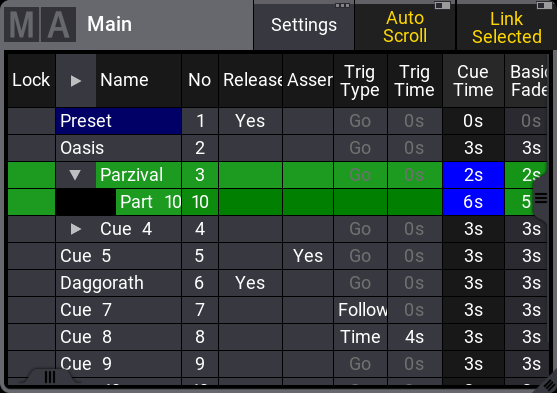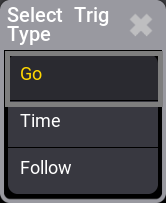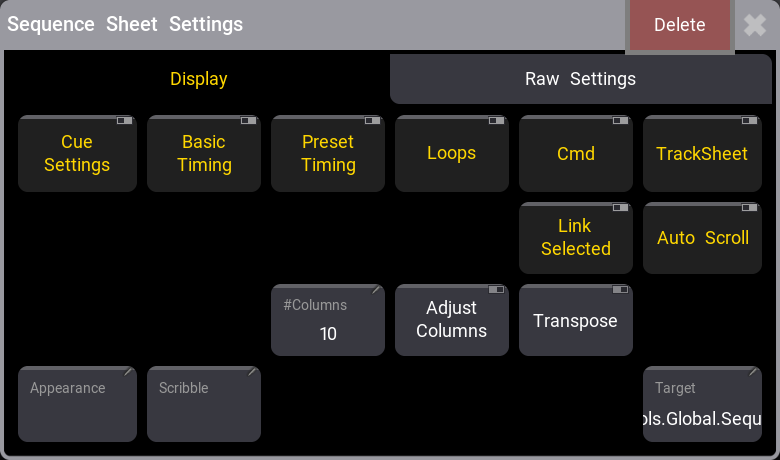- grandMA3 User Manual
- Introduction
- About the manual
- Symbols used in the manual
- System requirements grandMA3 onPC
- Installation of grandMA3 onPC
- Device Overview
- grandMA3 console
- grandMA3 replay unit
- grandMA3 processing units
- grandMA3 onPC command wing
- Keys
- Keys Overview
- . [Dot]
- <<< [GoFastBackward] | Black
- >>> [GoFastForward] | Flash
- - [Minus]
- + [Plus]
- / [Slash] | * [Asterisk/Multiply]
- At
- Assign
- Align
- Blind
- Clear
- Channel
- Copy
- Cue
- Down
- Delete
- Esc
- Edit
- Freeze
- Full
- Fixture
- Group
- Goto
- Go+ [large]
- Go- [large]
- Go+ | Temp
- Go- | Top
- Help
- Highlt [Highlight]
- If
- Learn | Rate1
- List
- MA
- Menu
- Move
- Next
- Numeric keys | arrows
- Oops
- On
- Off
- Pause [large]
- Pause | Fix
- Page+
- Page-
- Please
- Power
- Preset
- Prvw [Preview]
- Prev [Previous]
- Select
- SelFix [SelectFixture]
- Sequ [Sequence]
- Set
- Solo
- Stomp
- Store
- Thru
- Time
- Up
- Update
- U1
- U2
- X1 | Clone
- X2 | Link
- X3 | Grid
- X4 | Layout
- X5 | Step
- X6 | TC
- X7 | View
- X8 | DMX
- X9
- X10
- X11
- X12
- X13 | Phaser
- X14 | Macro
- X15 | Page
- X16 | Exec
- XKeys
- Control elements
- Dual encoders
- Level wheel
- Grand master
- Executor elements
- System Overview
- Standalone device
- Locally networked devices
- World server
- Parameters
- Calculate parameters
- Expand the amount of parameters
- First Steps
- Unpack the device
- Check scope of delivery
- Position the device
- Connect power
- Connect desk light
- Connect external screens
- Connect USB mouse and USB keyboard
- Connect DMX
- Connect Audio In
- Connect SMPTE (LTC)
- Connect Ethernet
- Connect DC Remote In
- Turn on the console the first time
- Show File Management
- Workspace
- User interface
- User-defined area
- Command line
- Control bar
- View buttons
- Grand master
- Tables in general
- Gestures
- Command section
- Master controls
- Playback controls
- Allocation of displays
- Encoder bar
- Feature group control bar
- Encoder toolbar
- Calculator
- Colors
- Icons
- User interface
- Command Syntax and Keywords
- General syntax rules
- Object keywords
- Function keywords
- Helping keywords
- All keywords
- / [Slash]
- . [Dot]
- .. [DotDot]
- <<< [GoFastBackward]
- >>> [GoFastForward]
- - [Minus]
- * [Asterisk]
- % [Percent]
- + [Plus]
- Absolute
- Acceleration
- Action
- Align
- AlignTransition
- Appearance
- Assign
- At
- Attribute
- Black
- Blind
- BPM
- Camera
- ChangeDestination
- Channel
- ChannelSet
- Chat
- Clear
- ClearActive
- ClearAll
- ClearSelection
- CmdDelay
- Configuration
- Console
- Copy
- Cue
- CueDelay
- CueFade
- CueInDelay
- CueInFade
- CueOutDelay
- CueOutFade
- Cut
- DataPool
- Decimal8
- Decimal24
- Default
- Delay
- Delete
- DelGlobalVar
- DelUserVar
- Dismiss
- DMXUniverse
- Down
- Drive
- Echo
- Edit
- EditOption
- Eject
- Effect
- EndIf
- Escape
- Exchange
- Executor
- Export
- Extract
- FaderMaster
- FaderRate
- FaderSpeed
- FaderTemp
- FaderX
- FeatureGroup
- Filter
- Fix
- Fixture
- Flip
- Flash
- Fog
- Freeze
- Full
- Gel
- GetGlobalVar
- GetUserVar
- Global
- Go-
- Goto
- Grid
- Group
- Help
- Hex8
- Hex24
- Highlight
- Houselights
- Hz
- If
- Insert
- Integrate
- Interface
- Invite
- Join
- Label
- Layout
- Leave
- Library
- List
- ListRef
- Load
- Loaded
- LoadShow
- Lock
- Login
- Logout
- Macro
- Master
- Media
- Move
- NewShow
- Next
- Node
- NonDim
- Normal
- Off
- On
- OnPC
- OSC
- Oops
- Page
- Part
- Park
- Paste
- Patch
- Pause
- Percent
- PercentFine
- Phase
- Physical
- Plugin
- Preset
- Press
- Previous
- Programmer
- PU
- Pyro
- Rate1
- Readout
- Reboot
- Recast
- Relative
- Release
- ReloadUI
- Remove
- Reset
- Restart
- SaveShow
- Scribble
- Seconds
- Select
- Selection
- SelFix
- Sequence
- SendOSC
- Set
- SetGlobalVar
- SetUserVar
- Shutdown
- SnapDelay
- Solo
- Station
- Step
- Stomp
- Store
- Temp
- Thru
- Top
- Transition
- Unlock
- Unpark
- Unpress
- Up
- Update
- User1
- User2
- User
- Version
- View
- Width
- Wing
- World
- Zero
- General syntax rules
- Windows, Views, and Menus
- Add windows
- Rearrange
- Store and recall views
- Remove windows from a screen
- Window settings
- Menus
- Change menu locations
- Pool windows
- Create pool object
- Label pool objects
- Move pool objects
- Insert pool objects
- Copy pool objects
- Lock and unlock pool objects
- Delete pool objects
- Networking
- Interfaces and IP
- Session
- Create a session
- Leave a session
- Invite to a session
- Dismiss from session
- Create a custom key
- DMX In and Out
- DMX port configuration
- Ethernet DMX
- Art-Net menu
- sACN menu
- Single User and Multi User Systems
- Create User
- User settings
- Patch and Fixture Setup
- What are fixtures
- Add fixtures to the show
- Live patch
- DMX sheet
- Remove fixtures from the show
- Position fixtures in the 3D space
- 3D Window
- Camera Pool
- Stages
- Classes and Layers
- Attribute definitions
- Activation group
- Feature group
- Operate Fixtures
- What is the programmer
- Fixture sheet
- Using the color picker
- Align
- Selection window
- Scribbles
- Create scribbles
- Edit scribbles
- Assign scribbles
- Delete scribbles
- Images
- Screenshots
- Appearance
- Create appearances
- Use appearances
- Delete appearances
- Groups
- Create groups
- Edit groups
- Delete groups
- Group masters
- Presets
- Preset pools
- Create presets
- Assign input filter
- Edit presets
- Update presets
- Preset pool settings
- Embedded presets
- Store values of multi steps
- Delete presets
- Worlds and Filters
- At filter
- Create a world
- Create a filter
- Use a world or filter
- Delete a world
- Delete a filter
- Cues and Sequences
- What is tracking
- Look at cues and sequences
- Sequence settings
- Store cues
- Store options and preferences
- Play back cues
- Cue timing
- Executors
- Assign object to an executor
- Executor configurations
- Running playbacks
- Phasers
- Step bar
- Phaser editor
- Create sinus dimmer phaser
- Macros
- Create macros
- Edit macros
- Assign macros to keys and buttons
- Timecode
- Toggle view mode
- What are timecode slots
- Layouts
- Create a layout
- Layout pool settings
- Edit layout
- Layout view settings
- Edit layout view
- Edit layout elements
- System Information
- Date and time
- Clock
- System info
- Update the Software
- Update grandMA3 consoles
- Update grandMA3 xport nodes
- Fixture Types
- Import fixture types
- Import GDTF
- Build fixture types
- Insert fixture types
- Insert DMX modes
- Insert geometries
- Insert models
- Link models to geometries
- Link DMX modes to geometries
- Export fixture types
- Export GDTF
- Import fixture types
- Introduction
- grandMA3 Quick Manual consoles
- grandMA3 Quick Manual processing
- grandMA3 Quick Manual nodes
- grandMA3 Quick Manual DIN-Rail
- grandMA3 Quick Manual onPC solutions
- Release Notes
New help version
The help version you selected belongs to an older software version. You may want to view the latest help version.
Look at Cues and Sequences
Table of contents of this topic
The different sequences are best seen in the Sequence Pool.
The best way to see the cues in a sequence is the Sequence Sheet:

The sheet shows the cues in rows. The different cue settings are in columns. Read below for a description of the different columns.
The purpose of this sheet is to see the cues in a sequence. It also shows the active cue with a green background. Cue fades and delays are visualized with moving bars while the fades are running.
Most values in the sheet can be edited. This can affect the look of the show. For instance the cue fade and delay times are stored when the cue is created. The default timing is used if nothing else is defined. The cue timing can be edited in this sheet.
Tapping this sheet to give it focus changes the encoder bar to make it easy to edit the cue timings. Read more about the bar below.
Title bar
The left side of the title bar has the MA logo. Tapping this opens the settings for the sheet. Read about them below.
Next to the logo is the name of the sequence the sheet is showing.
On the right side of the title bar are some buttons.
Settings open the sequence settings. Here it is possible to change different settings about the sequence. Read more in the Sequence Settings topic.
The Auto Scroll On/Off button toggles the automatic scrolling function. This will scroll the cues to keep the active cue visible in the screen.
Link Selected On/Off button toggles the function to automatically show the selected sequence. Turning it Off makes it possible to link the sheet to a specific sequence.
Main part of the sheet
The main part of the sheet is below the title bar. Here is the sheet with rows and columns.
This is a short description of each of the columns in the sheet:
- Lock:
This function is not implemented yet. - Name:
This is the cue name. If the cue contains part cues, then there is an arrow allowing to fold and unfold the parts. In the example above there are part cues in both cue 3 and 4. In cue 3 that are unfolded so they can be seen. In cue 4 they are folded and the parts are hidden. - No:
This is the cue number. - Release:
Changing the value to Yes in this cell makes the cue release tracked values. - Assert:
Changing the value to Yes in this cell makes the cue assert tracked values. - Trig Type:
There are three different trigger types. Editing this cell opens a small select pop-up

The options are: Go, Time, and Follow. This defines what triggers the execution of the cue. If it is Go then the cue needs a go command before it is triggered. Times means that it it triggers a set time after the previous cue is triggered(read below for how to set a time). Follow means that the cue will trigger after the previous cue is done with the Cue Time (which include all individual timing) - or a set time after this. - Trig Time:
This values stored here are only used if the trigger is Time or Follow.
If the trigger is Time, then the time in the cell will be used. The time starts counting down when the previous cue is triggered.
If the trigger is Follow, then the time in the cell will be used as a delay before the cue is triggered. When the time is 0, then the cue will trigger when the previous cue is done with the complete fade, delay, and individual times (cue time). - Cue Time:
This is the overall cue time transition time. It is a combination of the longest fade time and any delays. This is the time used with the Follow trigger. The cell cannot be edited. It always shows the complete transition time. - Basic Fade:
This is the fade time for all non-snap attributes and dimmer values that goes up in value. - Basic Delay:
This is the delay or wait time between the trigger and the actual basic fade begins. - Out Fade:
This is the fade time for dimmer values that does down in value. The default values for this is the same as the "Basic Fade" time - it is linked to the basic fade with the "Basic" value. - Out Delay:
This is the delay for the Out Fade (only dimmer values). Its default value is "Basic" - it is a link to the Basic Delay value. - Snap Delay:
This can be used to control when "Snap" attributes changes values. - "Preset type" Fade:
Each preset type have columns called the name of the preset type followed by "Fade". This uses the basic fade as a default. It can be changed here to give all values in the preset type a different fade time. All fixtures with new values in this preset type will use this timing. - "Preset type" Delay:
Each preset type have columns called the name of the preset type followed by "Delay". This uses the basic delay as a default. It can be changed here to give all values in the preset type a different delay time. All fixtures with new values in this preset type will use this timing. - Cmd Delay:
This will add a delay between the triggering of the cue and the execution of the command. See CMD below. - Cmd:
CMD is "Command". Commands (like the ones written the command line input) can be written in the cues. They are executed on the GlobalMaster, IdeMaster or Standalone station when the cue is triggered. - Indiv Fade:
This is "Individual Fade". It displays the time for attributes that have individual stored fade times. This cell cannot be edited. - Indiv Delay:
This is "Individual Delay". It displays the time for attributes that have individual stored delay times. This cell cannot be edited. - Indiv Time:
This is "Individual Time". It displays the overall time for attributes that have individual stored fade and delay times. This cell cannot be edited.
All cells with a light or dark gray background color can be edited and the value in the cell can be changed. Cells with a black background cannot be edited.
Sequence Sheet Settings
The settings for the sheet can be opened by tapping the MA logo on the left side of the title bar.

There are lots of different settings here that affect how the sheet looks and behaves. The following is a short description of them.
- Cue Settings:
This On/Off button show or hide the columns with the cue settings - Release, Assert, Trig Type, and Trig Time. - Basic Timing:
This On/Off button show or hide the columns with the basic timing - Basic Fade, Basic Delay, Out Fade, Out Delay, and Snap Delay. - Preset Timing:
This On/Off button show or hide the columns with the preset timings. - Loops:
This button does not do anything yet. - Cmd:
This On/Off button show or hide the columns related to the commands - Cmd Delay and Cmd. - TrackSheet:
This button does not do anything yet. - Link Selected:
This option is the same as the one in the title bar. If this is turned Off, then the sequence is selected using the Target option below. - Auto Scroll:
This options is also in the title bar. The sheet automatically scrolls so the active cue is visible. - #Columns:
This input button allow for a number of column to be set. This becomes relevant when the sheet is transposed - read below. - Adjust Columns:
This On/Off button can make the width of the columns automatically adjust to fit all the columns in the window. - Transpose:
This On/Off button can be used to transpose the sheet. - Appearance:
This input button can be used to select one of the existing Appearances from the pool. The selected appearance is assigned and displayed as a background in the window. - Scribble:
This function is not implemented yet. - Target:
This input button defines what sequence the sheet displays. If "link Selected" is turned Off, then this is where a sequence is defined.
At the moment you need to write the long absolute address for the sequence. For example to select a sequence labeled "Main" you need to write:
ShowData.DataPools.Global.Sequences.Main
If it is sequence number 5 without a label then it is:
ShowData.DataPools.Global.Sequences.Sequence 5
Sequence Edit Bar
The encoder bar changes when the Sequence Sheet has focus. The sheet can get focus by tapping the sheet.

Turning the two rings on the encoders changes the respective values for the cue that has focus in the sheet.
The lower row is the outer ring of the dual encoder. The top row is the inner ring of the dual encoders.


